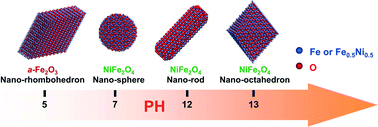Phase formations and magnetic properties of single crystal nickel ferrite (NiFe2O4) with different morphologies
Abstract
Nickel ferrite (NiFe2O4) nanomaterials with different morphologies, including nano-spheres (10–25 nm in diameter), nano-rods (50–60 nm in diameter and ~1 μm in length), and nano-octahedrons (side length ~150 nm), have been synthesized by a single mild hydrothermal method at 160 °C without any surfactant. The crystal structures have been investigated by TEM, HRTEM, and studied by simulations using the program Materials Studio. The variations in the morphology, as well as the preferential crystal growth directions, depend only on the pH value of the reaction solution. A phase formation mechanism is thus proposed. Magnetization measurements at T = 300 K indicate that the NiFe2O4 nano-spheres of 10–25 nm diameter are superparamagnetic with non-saturating magnetization at H = 7 kOe. The saturation magnetization, MS, of the nanorods is 40 emu g−1, less than the bulk value, MS = 46.7 to 55 emu g−1. The coercivity is HC = 40 Oe, reduced from the bulk value of 100 Oe. On the other hand, the nano-octahedrons have a saturation magnetization of MS = 50 emu g−1, the same as the bulk value. However the coercivity, HC = 50 Oe is also much reduced from the bulk value.


 Please wait while we load your content...
Please wait while we load your content...